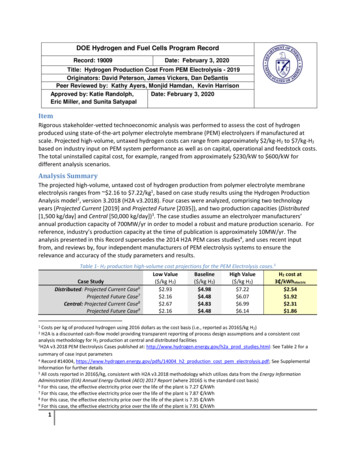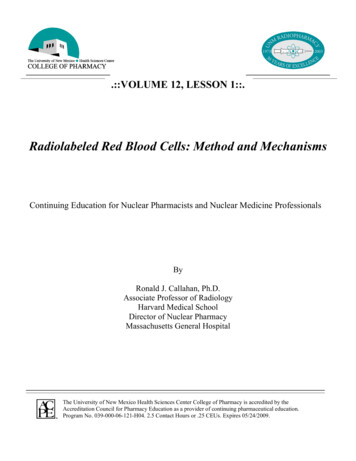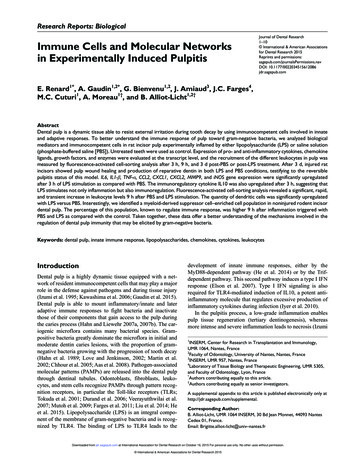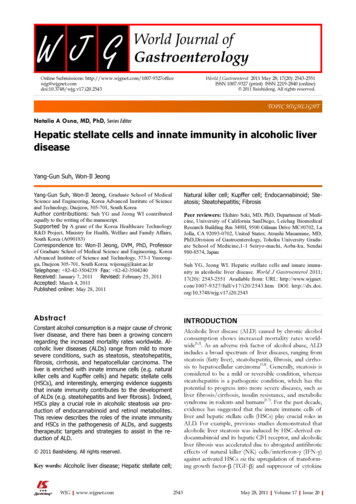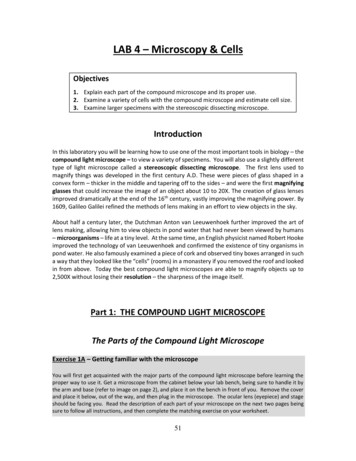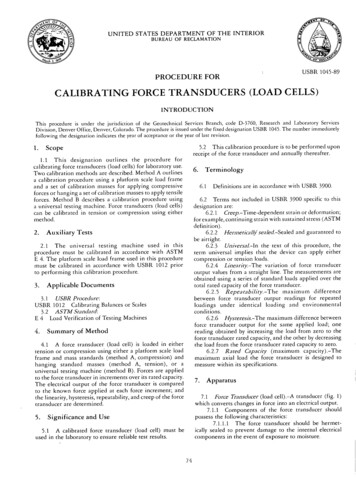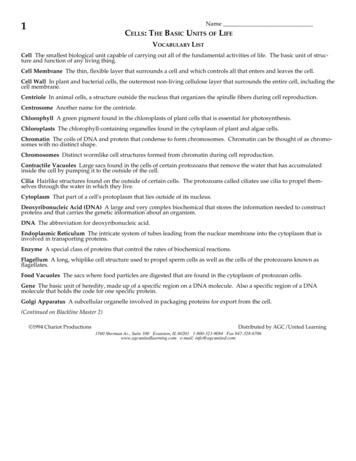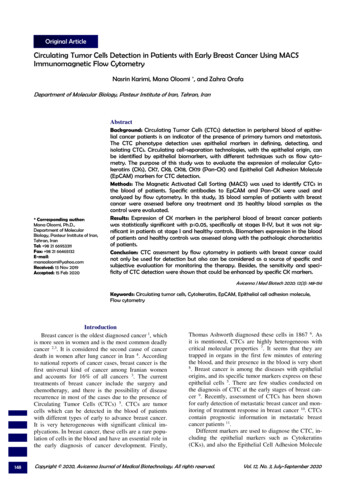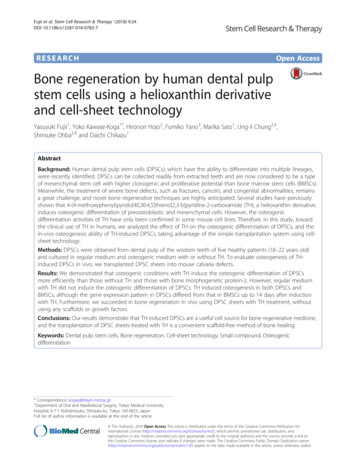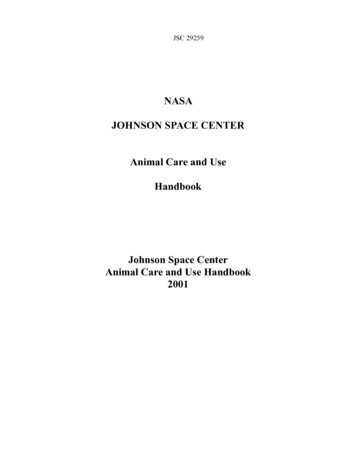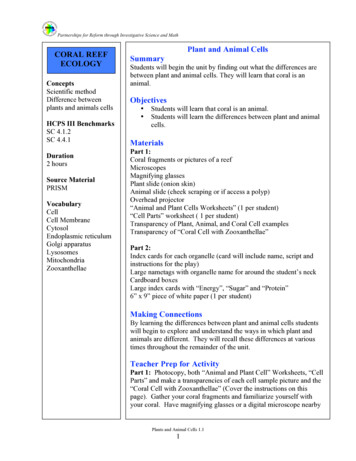
Transcription
Partnerships for Reform through Investigative Science and MathCORAL REEFECOLOGYConceptsScientific methodDifference betweenplants and animals cellsHCPS III BenchmarksSC 4.1.2SC 4.4.1Duration2 hoursSource MaterialPRISMVocabularyCellCell MembraneCytosolEndoplasmic reticulumGolgi apparatusLysosomesMitochondriaZooxanthellaePlant and Animal CellsSummaryStudents will begin the unit by finding out what the differences arebetween plant and animal cells. They will learn that coral is ananimal.Objectives Students will learn that coral is an animal.Students will learn the differences between plant and animalcells.MaterialsPart 1:Coral fragments or pictures of a reefMicroscopesMagnifying glassesPlant slide (onion skin)Animal slide (cheek scraping or if access a polyp)Overhead projector“Animal and Plant Cells Worksheets” (1 per student)“Cell Parts” worksheet ( 1 per student)Transparency of Plant, Animal, and Coral Cell examplesTransparency of “Coral Cell with Zooxanthellae”Part 2:Index cards for each organelle (card will include name, script andinstructions for the play)Large nametags with organelle name for around the student’s neckCardboard boxesLarge index cards with “Energy”, “Sugar” and “Protein”6” x 9” piece of white paper (1 per student)Making ConnectionsBy learning the differences between plant and animal cells studentswill begin to explore and understand the ways in which plant andanimals are different. They will recall these differences at varioustimes throughout the remainder of the unit.Teacher Prep for ActivityPart 1: Photocopy, both “Animal and Plant Cell” Worksheets, “CellParts” and make a transparencies of each cell sample picture and the“Coral Cell with Zooxanthellae” (Cover the instructions on thispage). Gather your coral fragments and familiarize yourself withyour coral. Have magnifying glasses or a digital microscope nearbyPlants and Animal Cells 1.11
Partnerships for Reform through Investigative Science and Mathso you can look closely at the calyx (the calyx is where the actual polyp lives). If you have premade slides of plant and animal cells, have them ready near your microscopes. If you need tomake your own slides, place a very thin slice of an onion on a clean microscope slide and put adrop of iodine on it (iodine can be purchased at most drug stores), and slide the cell cover overthe iodine and onion slice. To make an animal cell, scrape the lining of your inner cheek with atoothpick and smear the cells on a microscope slide. Place a drop of water on your cheek cellsand slip the slide cover on the water and cheek cells.A sample picture of each a plant, animal and coral cell slide has been provided at the bottom ofthis lesson plan.Part 2: Print the scripts for animal and plant cells. Cut out each cell part and paste it on a smallnote card. Write each cell part name on large note cards and punch two holes on either corner.Tie off yarn or string to create a necklace for nametags. Create an open space in your classroomfor where the play will take place.BackgroundOnly living things have cells. Plant cells can be distinguished from animal cells by threecharacteristics. First, plant cells are bounded by a cell membrane and a rigid cell wall, whereasanimal cells have only a cell membrane to protect their insides from the outside environment.Second, plant cells have mitochondria and chloroplasts (an organelle that uses photosynthesis) toproduce energy, while animal cells only have mitochondria. Finally, plant cells contain vacuolesstorage units-which are absent in many animal cells.The similarities between plant and animal cells are that they are both eukaryotic cells (cells thatcontain a nucleus). They share many kinds of cell parts (or organelles) such as the nucleus,mitochondria, endoplasmic reticulum, golgi apparatus, lysosomes, cytosol and cellmembrane.Coral polyps are living animals. Some corals have a symbiotic relationship with plant cells(zooxanthellae). These types of corals are typically found in areas close to the surface of waterso that the zooxanthellae can use photosynthesis to create energy. Because zooxanthellae usesless than 5% of the energy it produces while the rest goes to the corals, corals containingzooxanthellae are usually the reef-building types of corals. You can read more information oncoral cells here: ePart 1:1. Show the students a variety of coral skeletons and pictures. Ask the class what they think it is:a plant, animal, rock, etc. Ask inquiry types of questions:1. What observations can they make?2. If the organism is an animal, why?3. What is the difference between plants and animals?Make a list of all of the differences suggested by students. What purposes do thesedifferences serve? How are plants and animals similar? Which one do you think is morePlants and Animal Cells 1.12
Partnerships for Reform through Investigative Science and Mathcomplex? Have students use microscopes to observe the shapes of plant and animal cells.Optional: Have students draw a diagram of what they see under the microscope. Askstudents: “Why do you think the plant cell looks rectangular in shape?” “What otherdifferences do you see between the two cells?”2. Hand out the “Animal and Plant Cells Worksheets” and the “Cell Parts” worksheet. Explainthat only living organisms have cells.3. Go over the different parts of the two cells using the supplied “Teacher’s Answer Guide”diagrams. As you discuss each part, have a student or yourself read out loud to the class thedescription and function of each part from the “Cell Parts” worksheet. Have the studentscomplete the worksheets by filling in part as discussed. Explain to the class that the plantcell is rectangular in shape because the plant cell has a cell wall, and the cell wall is whatthey are looking at. The cell wall helps strengthen the plant cell and helps it withstand theelements of weather, such as wind, rain, and snow. The plant cell also contains chlorophyll(green in color) and the animal cell does not. The chlorophyll observed in the plant cellallows the plant to get energy from the sun and produce food in a process calledphotosynthesis. (http://www.girlstart.org/detectives/view lesson.asp?ID 595)4. After they have filled out their worksheets, show the students the picture of the coral cell withthe zooxanthellae and explain that it is a coral cell. Ask them, using the information they justlearned about the differences between plant and animal cells, if coral is a plant or an animal,or even if it is a mineral (only living things have cells). Do animals or plants have cell walls?Part 2:5. Pass out note cards with the organelle name and script on each card. Ask the students to splitup in two groups depending on their cell part: “plant cell” and “animal cell”. Each groupshould be able create a complete cell. They may use their worksheets from Part 1 to help.6. Remind the class that each cell part has an important function. Ask the students if they canremember a cell part and what function it does in the cell. Then, ask them if that functionreminds them of anything else that they know. For example, mitochondria makes energy forthe cell, and therefore reminds the student of a battery, or the nucleus directs the processes ofthe cell so it reminds them of a computer. Do this for each cell part.7. Explain that they will now create a puppet that represents the cell part indicated on theirnotecard. First, the they will create the mouth of the puppet. Instruct the students to fold the6”x9” sheet “hot-dog style” into 3 equal sections. Second, fold the sheet into a “W” indicatedin Fig. 1 on page 12. Explain that their fingers can be inserted into the folded gaps at eitherend of the “W” to make the mouth move up and down.8. Once the mouthpiece is done, the students can start designing their representative cell partusing construction paper, glue and their scissors. Their puppet should be designed based onan analogy of the cell part. Some examples have bee covered in Step 6, but students may beto come up with their own. Use the “Cell Parts” worksheet to help the students come up withan analogy based on the description and function for each cell part. See Fig. 2 on page 12.Plants and Animal Cells 1.13
Partnerships for Reform through Investigative Science and Math9. Once the students have finished their puppets, have each student read their script from thenote card in front of class, using the puppet to speak for them. Each student should be able torecognize if their cell part is found in a plant cell, animal cell, or in both cells. See Fig. 2 onpage 12 as an example.AssessmentsAssessment checklist (page 5)ResourcesOxford Illustrated Science TMExtension Activity/Art ConnectionChallenge your students to create a model of the animal and plant cell using playdoh or thingsfound around their house. Encourage them to use recycled materials or items that are used/nolonger of use.This can be done as a homework assignment or an in-class art activity. If you plan to do it inclass, then give the students advanced notice to collect supplies to build their coral polyp andbring them in to class.To review the parts of a cell and vocabulary, have the students label each part on their cell.Plants and Animal Cells 1.14
Partnerships for Reform through Investigative Science and MathName:Date:Animal and Plant Cells WorksheetQuestions:1. Which type of cell is this?2. How do you know which type of cell it is?Source: Oxford Illustrated Science se/pictures/nature/Plants and Animal Cells 1.15
Partnerships for Reform through Investigative Science and MathName:Date:Animal and Plant Cells WorksheetQuestions:1. Which type of cell is this?2. How do you know which type of cell it is?Source: Oxford Illustrated Science se/pictures/nature/Plants and Animal Cells 1.16
Partnerships for Reform through Investigative Science and MathName:Date:Cell PartsCell PartDescriptionFunctionCell (Plasma)MembraneNucleusSemi-permeable membranesurrounding the cell.Sperical, often in thecenter of the cell, boundedby a membrane (skin).Semi-fluid between the cellmembrane and the nucleus."Traffic-cop". It selects whatenters the cell.Cell brain or the "computer" ofthe cell. Contains information tomake the cell work.Jelly-like substance within thecell that holds up the other cellparts in the cells.It's the "warehouse" in a cellthat stores food and wasteproducts.It supports and creates theshape of a cell.Called the "powerhouse of thecell" because it creates energyfor the cell.It is the spot of photosynthesiswhere energy is made for plantcells.It is used to transport food orother materials from one part ofthe cell to another.It creates protein.CytoplasmVacuoleMembrane bound sack inthe plant cell.Cell WallSurrounds a plant cell.MitochondriaShaped like a football or apeanut in the cell.ChloroplastsGreen, similar in shape to amitochondria.EndoplasmicReticulumWhite, maze-like cell partsurrounding the nucleusRibosomesTiny, round organelles thatfloat around in thecytoplasm or attaches tothe Endoplasmic Reticulum.Golgi Apparatus Stacks of saucer-like(Body)membranesWorks with the EndoplasmicReticulum to transport materialsacross the cell.Plants and Animal Cells 1.17
Partnerships for Reform through Investigative Science and MathCoral Cell with ZooxanthellaThe picture below shows a coral cell that contains a symbiotic single celledalga called zooxanthella. Point out the parts of the coral cell to the classthat they just learned.Gates et al. Biol. Bull. 182: 324-332. (June. 1992)PM coral cell plasma MembraneZX ZooxanthellaeM MitochondriaVM plant cell vacuolar membranePlants and Animal Cells 1.18
Partnerships for Reform through Investigative Science and MathTeacher’s Cell Parts Answer GuideAnimal cell:MitochondriaNucleusGolgi raneSource: Oxford Illustrated Science se/pictures/nature/Plants and Animal Cells 1.19
Partnerships for Reform through Investigative Science and MathPlant cell:CytoplasmVacuoleCell WallCellMembraneChloroplastNucleusGolgi e: Oxford Illustrated Science se/pictures/nature/Plants and Animal Cells 1.110
Partnerships for Reform through Investigative Science and MathFig. 1. The students will first fold their 6”x9” paper into three parts. Second, theywill fold their papers A) with a “valley fold” in half, then B) two mountain folds. Thestudent should end up with a paper that’s folded in a “W”.Fig. 2. The students will create a puppet to represent their cell part. This is Mortythe Mitochondria. He is a battery that represents themitochondria of the cell.Plants and Animal Cells 1.111
Partnerships for Reform through Investigative Science and MathDirections: Cut up the script and paste each organelle part onto notecards.Each student will receive one notecard with one part from either the animalcell script or the plant cell script.Animal Cell Script:CELL MEMBRANEScript: “Hi, I’m a cell membrane. My job is to protect the insides ofthe cell from the outside environment.”Directions: Move on the far side of the play area with arms out in asemi-circle.CYTOPLASMScript: “I’m the cytoplasm. I am the gel-like substance between thecell membrane and the nucleus where the organelles are found.”Directions: Wave arms in front of yourself as you “float” around thecell between the other organelles.NUCLEUSScript: “I’m the mighty nucleus. I direct the cell activity to make surethat all of the other organelles in the cell do their jobs.”Directions: Stand in the middle of the play area and motivate theorganelles to work.Plants and Animal Cells 1.112
Partnerships for Reform through Investigative Science and MathE
Plants and Animal Cells 1.1 1 Making Connections Concepts Scientific method Difference between plants and animals cells HCPS III Benchmarks SC 4.1.2 SC 4.4.1 Duration 2 hours Source Material PRISM Vocabulary Cell Cell Membrane Cytosol Endoplasmic reticulum Golgi apparatus Lysosomes Mitochondria Zooxanthellae Plant and Animal Cells Summary Students will begin the unit by finding

